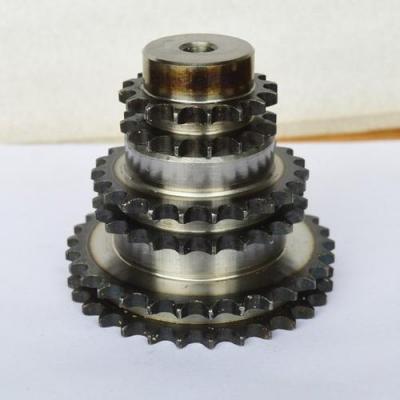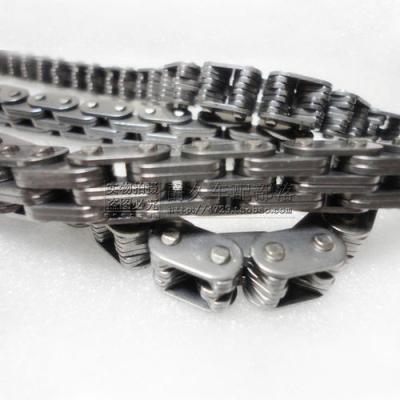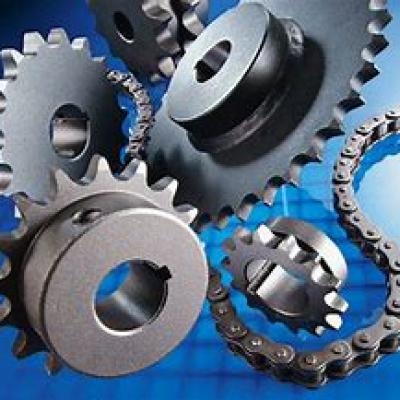Roller Chain drive design

Because the wear of the sprocket is preferably the same as the number of links in order to make the wear uniform and improve the life, the number of even links corresponds to the number of odd Finished Bore Sprocket .
In order to improve the smoothness of the chain drive and reduce the dynamic load, the number of teeth of the small sprocket is better. However, the number of small Stock Sprocket should not be too much, otherwise =i will be very large, so that the chain drive will have a skipping tooth failure earlier.
After the chain has been in operation for a period of time, the wear causes the pin to become thinner and the sleeve and the roller to be thinned. Under the tensile load F, the pitch of the chain is elongated. After the chain pitch becomes longer, the pitch circle d moves toward the top of the tooth when the chain is wound around the sprocket.
The larger the pitch of the chain, the higher the theoretical carrying capacity. However, as mentioned in the above section: the larger the pitch, the greater the dynamic load caused by the change of the chain speed and the impact of the chain link into the sprocket, which in turn reduces the chain carrying capacity and life.
Therefore, the design should use a small Short pitch precision roller chain(B series) as much as possible. The actual effect of selecting a small pitch multi-row chain during heavy load is often better than selecting a large pitch single-row chain.
If the chain transmission center distance is too small, the angle of the small sprocket is small, and the number of teeth of the meshing sprocket is small; if the center distance is too large, the chain is easy to shake. Generally, the center distance a = (30 ~ 50) p, the maximum center distance ≤ 80p.
Turn left | turn right
Extended data
Chain drive can be divided into three categories: lifting chain, traction chain and Conveyor Chain according to different purposes.
1. The lifting chain is mainly used for lifting heavy objects in the lifting machinery, and its working speed is v≤0.25m/s;
2. The traction chain is mainly used for moving heavy objects in chain conveyors, and its working speed is v≤4m/s; the Transmission Chain is used for transmitting motion and power in general machinery, and the working speed is usually v≤15m/s.
3. The transmission chain has two types: a toothed chain and a roller chain. The toothed chain is realized by the meshing of the chain and the sprocket of a specific tooth shape, and the toothed chain transmission is stable and the noise is small, so it is also called a silent chain transmission.
The toothed chain allows a working speed of up to 40 m/s, but it is expensive to manufacture and heavy, so it is often used in applications where high speed or motion accuracy is required. The chains used for power transmission mainly include sleeve roller chains and toothed chains.
The sleeve Roller Chain is composed of an inner chain plate, an outer chain plate, a sleeve, a pin shaft and a roller. The outer chain plate is fixed on the pin shaft, the inner chain plate is fixed on the sleeve, and the roller and the sleeve and the sleeve and the pin shaft are relatively rotatable, so that the meshing of the chain and the sprocket is mainly rolling friction. Sleeve roller chains can be used in a single column and in multiple columns. Multiple columns can be used to transfer large power.
The sleeve roller chain is lighter in weight, longer in life and lower in cost than the toothed chain. It is widely used in power transmission. The toothed chain is a combination of a plurality of pairs of working faces having a 60° angle with a pin.
The working face of the chain engages the sprocket. In order to prevent the chain from falling off the sprocket during operation, the chain is provided with an inner guide or an outer guide. When engaged, the guide piece is engaged with the corresponding guide groove on the sprocket.
The toothed chain transmission is stable and the noise is very small, so it is also known as the silent chain, which is often used for high speed transmission. The tooth profile of the sleeve roller chain and the toothed chain sprocket should ensure that the chain is energy-saving free to enter or exit the engagement, the impact is small when engaged, and the contact is good when engaged.





